Data leaders from across industries gathered to explore how to scale AI initiatives, navigate legacy systems, and unlock long-term value through strategic data management.
Last week, Rewire welcomed senior data leaders for the second edition of the Data Leadership Roundtable. Held at our Amsterdam office, the event brought together executives from a broad range of organizations – Shell, Rabobank, Heineken, AFM, KPN, Terberg, a.s.r. and many more – for an open exchange on two urgent challenges in data strategy: how to balance investment trade-offs to unlock value, and how to scale AI and data initiatives in environments dominated by legacy systems.

Industry leaders at the table.
The morning began with a plenary perspective from Rewire Partner Helen Rijkes, who reflected on the dramatic evolution of data work—from manual reporting using SPSS over 15 years ago to today's modern data environments, shaped by the shift toward domain-based data ownership and emerging technologies such as GenAI. She emphasized that the challenge isn’t building isolated use cases, but rather scaling them into sustained, organization-wide value. Success, she argued, comes from strategic balancing between consistent capability building and scaling value cases while embedding secure data access policies at scale.

Helen Rijkes, Partner at Rewire, reflecting on the evolution of data management in recent years.
The plenary was followed by a panel discussion featuring Annemarie de Beer (AFM), Gijs Thieme (KPN), Maarten Kramer (a.s.r.), and Sam van Kesteren (Royal Terberg Group). Their conversation explored how organizations balance central and decentralized approaches to data, with many agreeing that centralized data science teams help avoid fragmentation, while local business ownership is critical for adoption. They also examined the ongoing tension between building versus buying solutions, noting that while building is attractive for strategic control and internal talent, buying can accelerate implementation—provided there's clarity on vendor limitations and alignment with business needs. Finally, the panel addressed legacy systems, emphasizing that successful transformation requires not only technical migration but also strong change management and alignment across business and IT.

Annemarie, Gijs, Maarten, and Sam share their perspectives on common data strategy challenges
After the panel, the group split into four breakout discussions, each diving deeper into the practical realities of leading data strategy in complex environments. In one group, participants discussed the evolving role of data scientists, the importance of aligning platform decisions with long-term strategy, and the challenge of ensuring responsible access to both structured and unstructured data. Another group focused on why so many AI initiatives get stuck in the proof-of-concept phase, concluding that without the right infrastructure, skills, and business engagement, even promising pilots can fail to scale. A third group explored how to move from compliance-driven data management to a value-driven model, especially in regulated industries, while also grappling with new ethical questions introduced by AI. And in the fourth group, participants reflected on the importance of embedding AI into day-to-day decision-making, emphasizing that adoption—not just technical readiness—is what ultimately drives success.

Sharing challenges. Shaping solutions. Together.
Throughout the day, one message came through clearly: the real challenge in data and AI transformation isn’t just technical—it's organizational. Success depends on bridging silos, aligning stakeholders, embedding data into business processes, and building the trust and capabilities needed to move from experimentation to impact.
We’re incredibly grateful to all participants for their insights and participation. The conversations reaffirmed the importance of community in tackling the complex challenges when executing your data strategy in the Data & AI landscape of today. We look forward to continuing that dialogue in future roundtables.
A handful of principles will set you up for success when bringing GenAI to enterprise data.
As highlighted in our 2025 Data Management Trends report, the rapid evolution of LLMs is accelerating the shift of GenAI models and agentic systems from experimental pilots to mission-critical applications. Building a proof of concept that taps a single data source or uses a few prompts is relatively simple. But delivering real business value requires these models to access consistent, high-quality data—something often trapped in silos, buried in legacy systems, or updated at irregular intervals.
To scale from pilot to production, organizations need a more structured approach—one grounded in solid data management practices. That means integrating with enterprise data, enforcing strong governance, and ensuring continuous maintenance. Without this foundation, organizations risk stalling after just one or two operationalized GenAI use cases, unable to scale or accommodate new GenAI initiatives, due to persistent data bottlenecks. The good news is that those early GenAI implementation efforts are the ideal moment to confront your data challenges head-on and embed sustainable practices from the start.
How, then, can data management principles help you build GenAI solutions that scale with confidence?
In the sections that follow, we’ll look at the nature of GenAI data and the likely challenges it poses in your first value cases. We’ll then explore how the right data management practices can help you address these challenges—ensuring your GenAI efforts are both scalable and future-proof.
Understanding the nature of GenAI data
GenAI data introduces a new layer of complexity that sets it apart from traditional data pipelines, where raw data typically flows into analytics or reporting systems. Rather than dealing solely with structured, tabular records in a centralized data warehouse, GenAI applications must handle large volumes of both structured and unstructured content—think documents, transcripts, and other text-based assets—often spread across disparate systems.
To enable accurate retrieval and provide context to the model, unstructured data first be made searchable. This typically involves chunking the content and converting it into vector embeddings or exposing it via a Model Context Protocol (MCP) server, depending on the storage provider (more on that later). Additional context is increasingly delivered through metadata, knowledge graphs, and prompt engineering, all of which are becoming essential assets in GenAI architectures. Moreover, GenAI output often extends beyond plain text. Models may generate structured results—such as function calls, tool triggers, or formatted prompts—that require their own governance and tracking. Even subtle variations in how text is chunked or labeled can significantly influence model performance.
Because GenAI taps into a whole new class of data assets, organizations must treat it differently from standard BI or operational datasets. This introduces new data management requirements to ensure that models can reliably retrieve, generate, and act on timely information—without drifting out of sync with rapidly changing data. By addressing these nuances from the outset, organizations can avoid performance degradation, build trust, and ensure their GenAI solutions scale effectively while staying aligned with business goals.
Start smart: consider data representability
Selecting your first GenAI value case to operationalize is a critical step—one that sets the tone for everything that follows. While quick experiments are useful for validating a model’s capabilities, the real challenge lies in integrating that model into your enterprise architecture in a way that delivers sustained, scalable value.
Choosing the right value case requires more than just identifying an attractive opportunity. It involves a clear-eyed assessment of expected impact, feasibility, and data readiness. One often overlooked but highly valuable criterion is data representability: how well does the use case surface the kinds of data challenges and complexities you’re likely to encounter in future GenAI initiatives?
Your first operationalized value case is, in effect, a strategic lens into your data landscape. It should help you identify bottlenecks, highlight areas for improvement, and stress-test the foundations needed to support long-term success. Avoid the temptation to tackle an overly ambitious or complex use case out of the gate—that can easily derail early momentum. Instead, aim for a focused, representative scenario that delivers clear early wins while also informing the path to sustainable, scalable GenAI adoption.
Don’t get stuck: Answer these critical data questions
The targeted approach described above delivers the early tangible win needed to get stakeholder buy-in—and, more critically, it exposes underlying data issues that might otherwise go unnoticed. Here are typical data requirements for your first GenAI use case, along with the key challenge they create and core questions you’ll need to answer.
| Requirement | Challenge | Key questions |
| Integrated information | Previously untapped information (for example, pdf documents), is now a key data source and must be integrated with your systems. | * Where is all this data physically stored? Who maintains ownership of each source? * Do you have the necessary permissions to access them? * Does the data storage tool provide a MCP server to interact with the data? |
| Searchable knowledge system | Searchable documents must be chunked, embedded, and updated in a vector database—or exposed via an MCP server—creating new data pipeline and infrastructure demands. | * Can you find a reliable embedding model for capturing the nuances in your business? * How frequently must you re-embed to handle updates? * Are the associated costs manageable at scale? |
| Context on how data is interconnected | Reasoning capabilities require explicitly defined relationships—typically managed through a knowledge graph. | * Is your data described well enough to construct such a graph? * Who will ensure these relationships and definitions stay accurate over time? |
| Retrieval from relational databases by an LLM | Models need rich, well-documented metadata to understand and accurately query relational data. | * Are vital metadata fields consistent and detailed? * Do you have the schemas and documentation required for the model to navigate these databases effectively? |
| Defining prompts, output structures and tool interface | Prompts, interfaces, and outputs must be reusable, versioned, and traceable to scale reliably and maintain trust. | * How do you ensure these prompts and interfaces are reusable? * Can you track changes for auditability? * How do you log their usage to troubleshoot issues? |
| Evaluate model outputs over time | User feedback loops are essential to monitor performance, but collecting, storing, and acting on feedback systematically is lacking. | * How do you store feedback? * How do you detect dips in accuracy or relevance? * Can you trace poor results back to specific data gaps? |
| Access to multiple data sources for the LLM | GenAI creates data leakage risks (e.g. prompt injection), requiring access controls to secure model interactions. | * Which guardrails or role-based controls prevent unauthorized data exposure? * How do you ensure malicious prompts don’t compromise the agent? |

Transform potential into performance with GenAI
Whether you win or lose in your market may soon rely on having the best GenAI capability and the data foundations to support it. We can help you build this.
Discuss your needsLook beyond your first pilot: apply data product thinking -from day one
A common mistake is solving data challenges only within the narrow context of the initial pilot—resulting in quick fixes that don’t scale. As you tackle more GenAI projects, inconsistencies in data structures, metadata, or security can quickly undermine progress. Instead, adopt a reusable data strategy from day one—one that aligns with your broader data management framework.
Treat core assets like vector databases, knowledge graphs, relational metadata, and prompt libraries as data products. That means assigning ownership, defining quality standards, providing documentation, and identifying clear consumers—so each GenAI use case builds on a solid, scalable foundation.
Core data product ingredients for GenAI
Below, we outline the key principles for making that happen, along with examples, roles, and how to handle incremental growth.
1. Discoverability
Implement a comprehensive data catalogue that documents what data exists, how it's structured, who owns it, and when it's updated. This catalogue should work in conjunction with—but not necessarily be derived from—any knowledge graphs built for specific GenAI use cases. While knowledge graphs excel at modelling domain-specific relationships, your data catalogue needs broader enterprise-wide coverage. Include the metadata and examples needed for generating SQL queries, as well as references for your vector database. (This is something we find particularly useful, for example when developing AI agents that autonomously generate SQL queries to search through databases. Curated, detailed metadata, including table schemas, column definitions, and relationships allow the agents to understand the structure and semantics of the databases.) Define a scheduled process to keep these inventories current, to ensure that new GenAI projects can easily discover existing datasets or embeddings, while avoiding unnecessary re-parsing or re-embedding of data that is already available.
2. Quality standards
This includes a range of processes. From reviewing PDF documents to remove or clarify checkboxes and handwritten text to checking chunk-level completeness for embeddings, consistent naming conventions, or standardized templates for prompt outputs. Involve domain experts to clarify which fields or checks are critical, and align those standards in your data catalogue. By enforcing requirements at the source, you prevent silent inconsistencies (like missing metadata or mismatched chunk sizes) from undermining your GenAI solutions later on.
3. Accessibility
GenAI models require consistent, reliable ways to retrieve information across your enterprise landscape—yet building a custom integration for every data source quickly becomes unsustainable. As an example, at a client a separate data repository was created—with its own API and security—to pull data from siloed systems. This is where the MCP comes in handy: by specifying a standard interface for models to access external data and tools, it removes much of the overhead associated with custom connectors. Not all vendors support MCP but adoption is growing (OpenAI for example provides it). So keep that in mind and avoid rushing into building custom connectors for every system. In sum, focus on building a solid RAG foundation for your most critical, large-scale enterprise data—where the return on investment is clear. For simpler or lower-priority use cases, it may be better to wait for MCP-ready solutions with built-in search, rather than rushing into one-off integrations. This balanced approach lets you meet immediate needs while staying flexible as MCP adoption expands. (We’ll dive deeper into MCP in our next blog post.)
4. Auditability
Log every step—when doing at least make sure to include knowledge graph updates to prompts, reasoning, and final outputs—so you can pinpoint which data, transformations, or model versions led to a given response. This is especially vital in GenAI, where subtle drifts (like outdated embeddings or older prompt templates) often go unnoticed until user trust is already compromised. From a compliance perspective, this is critical when GenAI outputs influence business decisions. Organizations may need to demonstrate exactly which responses were generated, what processing logic was applied, and which data was used at specific points in time—particularly in regulated industries or during audits. Ensure each logged event links back to a clear version ID for both models and data, and store these audit trails securely with appropriate retention policies to meet regulatory, privacy, and governance requirements.
5. Security & access control
Ensure appropriate role- and attribute-based access is enforced on all data sources accessed by your model, rather than granting blanket privileges. Align access with the end-user's identity and context, preventing the model from inadvertently returning unauthorized information. Be particularly vigilant about prompt injection attacks—where carefully crafted inputs manipulate models into bypassing security controls or revealing sensitive information. This remains one of GenAI's most challenging security vulnerabilities, as traditional safeguards can be circumvented through indirect methods. Consider implementing real-time checks, especially in autonomous agent scenarios, alongside an "LLM-as-a-judge" layer that intercepts and sanitizes prompts that exceed a user's permissions or exhibit malicious patterns. While no solution offers perfect protection against these threats, understanding the risk vectors and implementing defence-in-depth strategies significantly reduces your exposure. Resources like academic papers and technical analyses on prompt injection techniques can help your team stay informed about this evolving threat landscape.
6. LLMOps
A shared, organization-wide LLMOps pipeline and toolkit gives every GenAI project a stable, reusable foundation—covering everything from LLM vendor switching and re-embedding to common connectors and tool interfaces. Centralizing these resources eliminates ad-hoc solutions, promotes collaboration, and ensures proper lifecycle management. The result: teams can launch GenAI initiatives faster, apply consistent best practices, and still stay flexible enough to experiment with different models and toolchains.
The takeaway: combine your GenAI implementation with proper data management
Implementing GenAI models and agentic systems isn’t just about prompting an LLM. It’s a data challenge and an architectural exercise. By starting with a high-impact use case, you secure immediate value and insights, while robust data management practices ensure you stay in control—maintaining quality and trust as AI spreads across your organization. By adopting these principles in your very first GenAI initiative, you avoid the trap of quick-win pilots that ultimately buckle under growing data complexity. Instead, each new use case taps into a cohesive, well-governed ecosystem—keeping your AI agents current, consistent, and secure as you scale.
Those who excel at both GenAI innovation and data management will be the ones to transform scattered, siloed information into a unified, GenAI-ready asset—yielding genuine enterprise value on a foundation built to last. If you haven’t already established data management standards and principles, don’t wait any longer—take a look at our blog posts on data management fundamentals part 1 and 2.
If you’d like to learn more about building a robust GenAI foundation, feel free to reach out to us.
This article was written by Daan Manneke, Data & AI Engineer at Rewire and Frejanne Ruoff, Principal at Rewire.
Managing change across interconnected data products is hard. A robust versioning strategy is key avoiding chaos and build a resilient, innovation-ready data ecosystem.
Many organizations are shifting towards federated data management setups in which data management is largely decentralized, enabling domains to develop their own data products. It’s an attractive model for large enterprises, promising reduced bottlenecks from central teams, faster innovation, and domain-specific decision-making.
In short: scalable data management!
However, decentralization introduces complexity, both technical and organizational. Take data interoperability as an example: as each domain builds and manages its own data products, integrating data across domains becomes increasingly complex. Different data models, formats, schemas and definitions make it hard to ensure easy data integration.
Other areas of concern include data security, discoverability and quality. As data products become more interconnected – where one product’s output feeds into another, especially across domains – another significant challenge emerges: managing changes made to these products. Without a well-coordinated versioning strategy, this can quickly lead to cascading disruptions in the data ecosystem.
In this blog post, we’ll explore why a versioning strategy is critical, why it is particularly complex in federated set-ups, and what makes a good data versioning strategy.
In a mesh of interconnected data products, a coordinated versioning strategy is critical
In a typical mesh of data products, these products don’t operate in isolation. They are usually interdependent, where one product’s input is another product’s output. This creates a complex web of relationships. When a change is made to one data product—whether it is an update, bugfix, or new feature release—it affects all downstream products (see below figure).
Figure 1: Potential consequences if one data product changes in a mesh of connected data products
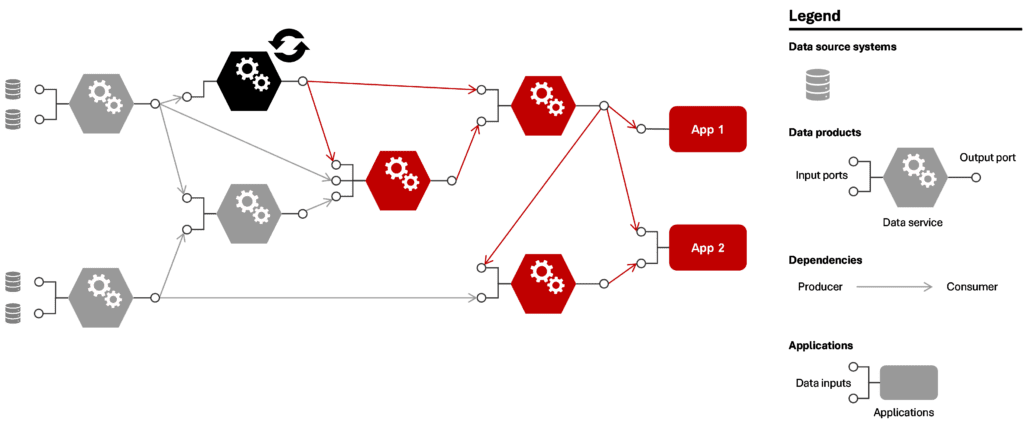
Even when changes happen infrequently, the interconnected nature of the system can cause the impact to snowball quickly. This is referred to as a cascading failure: a single change can spread through the system and cause unexpected behavior in products far removed from the original change. This makes it crucial to carefully manage dependencies and changes to maintain system stability.
Long-term consequence: loss of trust
Because relatively small changes can have such big impacts and lead to an unstable mesh, it can eventually erode trust in the entire system of data products. Over time, this lack of trust may push teams to revert to outdated methods like point-to-point connections or duplicating upstream data products, undermining the benefits of a decoupled (federated) approach.
What drives complexity in data product versioning in a federated set-up
Three aspects of data product versioning render the task complex. Let’s review them turn by turn.
1. Versioning is a significant technical challenge that goes beyond tracking data changes
Versioning presents a significant technical challenge. It’s not just about tracking changes in the data itself. It also involves managing the versioning of data transformation code, deployment code, access control policies, required packages, and supporting infrastructure. Extensive rollback capabilities are needed so that when something goes wrong, everything can be quickly and easily reverted back to a stable state.
How can we keep this mesh of interconnected data products healthy and stable while still allowing teams to innovate and release new updates?
2. More teams managing versions means greater complexity
In a federated set-up, data product versioning is no longer handled by a central team but by each domain independently. As a result, it becomes crucial to establish clear processes for version management across the organization. Without centralized oversight, coordinating large upgrades and ensuring alignment between domains can easily become unmanageable.
3. Innovation and business continuity are often at odds
Lastly, it can be difficult to balance innovation and stability. While decentralized approaches are often introduced to foster innovation and give teams greater freedom to ship new versions and iterate quickly, they must also ensure that changes don’t disrupt downstream consumers—or, in the worst case, compromise business continuity. This challenge grows as domains and interconnected data products proliferate.
Client example: In one organization, data products were initially built and maintained by a central data team. While this ensured stability, it also created long lead times and bottlenecks for new data needs. To speed up delivery, domain teams were allowed to develop their own data products. This worked well at first, but as teams began to use each other's outputs, this system quickly broke down: changes like renaming a column or modifying a metric caused dashboards to fail and models to crash, often without warning. With no shared versioning strategy in place, teams unintentionally disrupted each other almost weekly. The lack of transparency and coordination made the system nearly unmanageable. This example is not unique: it is typical of many organizations transitioning to a federated data model.
What makes a good data versioning strategy?
Given these complexities, organizations need to adopt a coordinated approach to data product versioning. Here we discuss three key components of a successful versioning strategy. Let’s review them one by one.
1. Unified versioning standards across domains
To avoid fragmentation and promote cross-domain data consumption, teams should follow consistent versioning guidelines that ensure clarity and interoperability across domains. These guidelines could include:
- Semantic versioning . This is a best practice versioning system adopted from software engineering, which distinguishes between major, minor, and patch updates. This approach data products updates to be labelled depending on the magnitude of the change and expected impact for consumers. As an example, semantic versioning for data products could look like the following:
- Patches involve bug fixes and performance optimizations.
- Minor updates introduce new capabilities, non-breaking to consumers, such as added columns and additional observability elements.
- Major updates are likely breaking to consumers, such as data type changes and definition changes.
- Unified communication mechanisms to notify stakeholders of upcoming changes, preferably automated when breaking changes are coming up.
- Clear documentation of changes, including expected impact on dependent data products, following the semantic versioning format and captured in changelogs.
The level of standardization should match the organization's complexity - too rigid frameworks can unnecessarily hinder innovation in smaller teams, while too loose approaches can lead to chaos in organizations with many domains.
2. Clear management of dependencies
In highly interconnected data ecosystems, dependency management must be explicit and transparent to prevent downstream failures. By giving downstream consumers visibility and time to adapt, organizations can prevent cascading failures and system instability. Key measures include:
- Transparency in data lineage. That is, ensuring that teams know where their data originates from, and which consumers depend on their data products.
- Structured rollout strategies such as parallel releases. This allows new and old versions to coexist for a transition period (a.k.a. the grace period) during which consumers have time to adapt before the old version is deprecated.
Client example: At a large financial institution, domain teams were unaware of the consumers of their data assets, or the use cases downstream of their data products. This resulted in slightly different versions of the same data being used throughout the organization. By adopting an approach that provided company-wide visibility into data lineage, and automatically updating it based on changes in data production and consumption, the client was able to untangle the ‘data spaghetti’ that had emerged from a lack of oversight.
3. Automation and tooling
Automated versioning is near-essential to make maintenance of data products efficient at scale, and error-free. Automation reduces human error, accelerates version rollouts, and ensures that versioning remains consistent and manageable even as the number of data products grows. Key elements include:
- Rollback capabilities to revert to stable versions when issues arise.
- Automated validation and testing to detect compatibility issues before deployment.
- Versioning as code, where versioning rules and policies are embedded in infrastructure and deployment pipelines.
- Developer tools that integrate with CI/CD pipelines, making versioning seamless for data engineers.
Client example: At one of our clients, we made the changelog an integral component in the lifecycle of data products. Through this approach, data products could not be altered without updating the changelog, making the changelog the source of truth for deployments and data product evolution. The CI/CD process for testing and deploying data products included analysis of the changelog, extracting the changes of the document, testing if these were following the intended versioning strategy (e.g. not skipping versions, checking if the documents includes information on the changes, analyzing whether it involves breaking changes), and if successful: deploying the data product, by changing the infrastructure and transformation logic according to the pre-defined deployment strategy. This approach improved the governance of data products in the organization and made it easier for data product builders to roll out changes.
Conclusion
For organizations adopting federated data management, the way they approach data product versioning can be the deciding factor in the success or failure of their data mesh. A strong versioning strategy is more than just a technical necessity - it is the foundation for maintaining a stable yet flexible data ecosystem. The key is to strike the right balance: ensuring interoperability between domains, without hindering innovation. By setting clear standards, proactively managing data dependencies, and using automation, organizations can ensure that their federated data products evolve seamlessly - allowing teams to innovate while keeping the ecosystem resilient and reliable.
This article was written by Job van Zijl, Senior Data Engineer at Rewire and Tamara Kloek, Principal at Rewire.
Unlocking true intelligence with memory, strategic planning, and transparent performance management
The rise of intelligent AI agents marks a shift from traditional task automation toward more adaptive, decision-making systems. While many AI-powered workflows today rely on predefined rules and deterministic processes, true agentic AI goes beyond fixed automation—it incorporates memory, reasoning, and self-improvement to adapt and autonomously achieve specific goals.
The previous agentic AI blog post explained the building blocks (memory, planning, tools and actions), use cases, and potential for autonomy. It positioned AI agents not just as tools for automating repetitive tasks but as systems capable of enhancing workflow efficiency and tackling complex problems with some degree of independent decision-making. In this blog post, we explore how these agents can be seamlessly integrated into real-world scenarios, striking a balance between cognitive science theory and the practical realities of human-agent interaction, with a particular focus on the memory and planning building blocks, alongside the addition of performance management.
Moving from models to real-world AI agents
Scaling AI agents presents challenges. While they can improve efficiency, their success depends on integration with existing systems. Use cases like personal assistants and content generators demonstrate clear value, whereas others struggle with reliability and adaptability.
Current LLM-based workflow automation relies on knowledge—whether through large reasoning models or knowledge bases. However, these agents often lack persistent memory, meaning they re-solve the same issues repeatedly. Without storing and leveraging past experiences, they remain reactive rather than truly intelligent. To bridge this gap, AI agents need:
- Memory – Retaining and applying past experiences.
- Ability to plan – Setting goals, adapting strategies, and managing complexity.
- Transparent performance management – Ensuring alignment, oversight, and trust.
These elements go beyond the building blocks of tools and actions, which have already been widely discussed in AI agent design. Here we focus on memory, planning, and performance management, as they represent critical design choices to move toward AI agents that are not just reactive task automators, but intelligent, adaptable decision-makers capable of handling more sophisticated tasks in real-world scenarios. Let’s start by exploring what intelligence in that sense even means.
Memory: the key to true intelligence
True intelligence goes beyond automation. An AI agent must not only process information but also learn from past experiences to improve over time. Without memory, an AI agent would remain static, unable to adapt or evolve. By integrating memory, reasoning, and learning, an intelligent AI agent moves beyond simply performing predefined tasks. In our previous blog post on AI agents, we explained that memory, planning, tools and actions are the building blocks of agents. Now, let's examine how memory plays a crucial role in enhancing an AI agent's capabilities. In cognitive science, memory is divided into:
- Semantic memory – A structured database of facts, rules, and language that provides foundational knowledge.
- Episodic memory – Past experiences that inform future decisions and allow for adaptation.
The interplay between semantic and episodic memory enables self-improvement: experiences enrich knowledge, while knowledge structures experiences. When agents lack episodic memory, they struggle with contextual awareness and must rely solely on predefined rules or external prompting to function effectively. To obtain intelligent agents, episodic memory is therefore crucial. By organizing past interactions into meaningful units (through chunking), agents can recall relevant solutions, compare them to new situations, and refine their approach. This form of memory actively supports an agent’s ability to reflect on past actions and outcomes.
To illustrate this, let's consider an example from supply chain management, as depicted in the image below. An AI agent that tracks delivery data, inventory, and demand can improve logistics by learning from past experiences. If the agent identifies patterns, such as delays during certain weather conditions or peak seasons, it can proactively adjust shipping schedules and notify relevant stakeholders. Without memory, the agent would simply repeat tasks without optimizing them, leading to inefficiencies and missed opportunities for improvement.
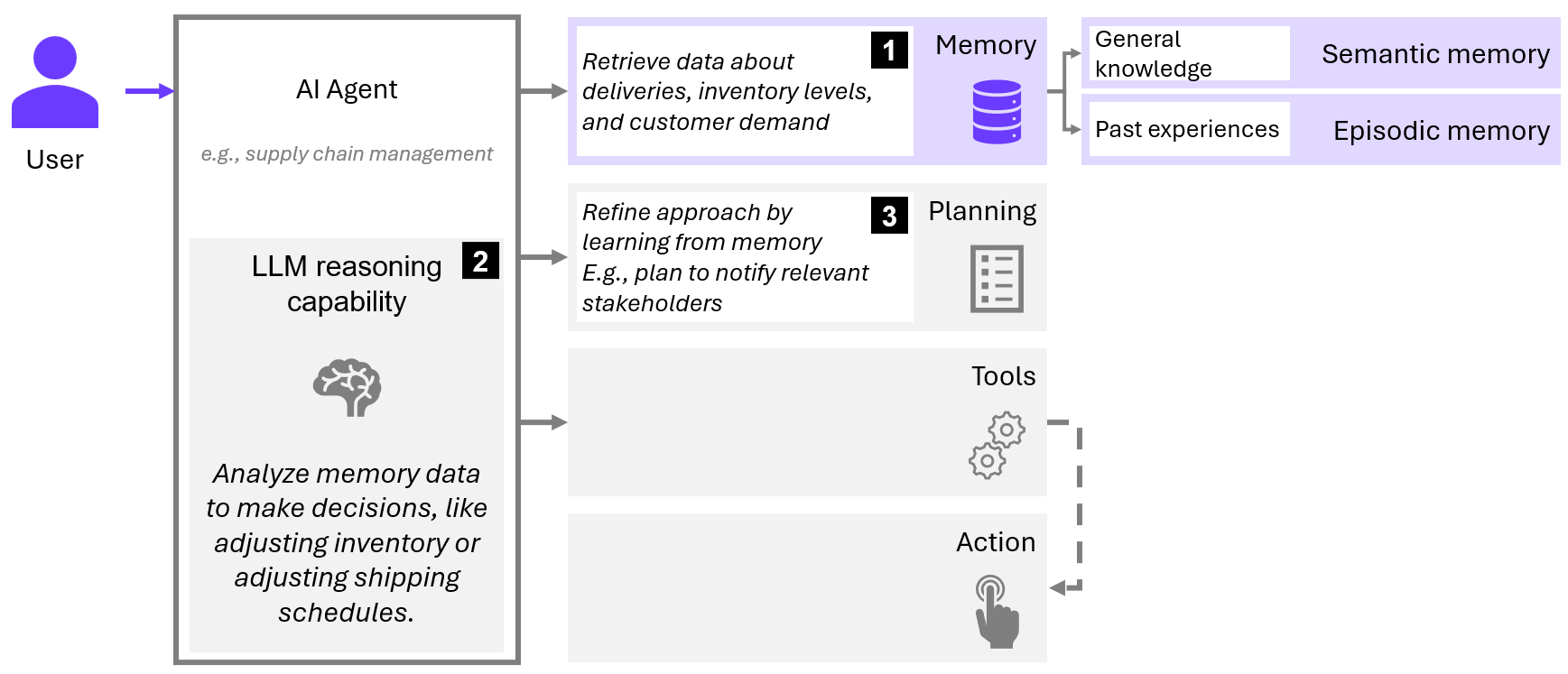
Figure 1 - Memory in AI Agents - An example from supply chain management
Ability to plan: the foundation for autonomous decision-making
Intelligent AI agents must dynamically plan and break complex problems into manageable tasks—mirroring the analytical nature of the human mind. Unlike rule-based automation, these agents should be able to assess different strategies, evaluate potential outcomes, and adjust their approach based on real-time feedback. Planning allows an agent to remain flexible, ensuring it can pivot when conditions change rather than blindly following predefined sequences.
LLMs serve as the reasoning engines of AI agents, showcasing increasingly advanced cognitive abilities. However, they struggle with long-term memory and sustained focus—much like the human mind under information overload. This limitation poses challenges in designing AI agents that must retain context across extended interactions or tackle complex problem-solving tasks.
A critical design question is whether an agent should retain plans internally or offload them to an external tool. Keeping plans within an LLM provides full information access but may be limited by context constraints. For example, an AI managing a real-time chat-based customer support system could benefit from internal memory to dynamically adapt to an ongoing conversation, keeping track of the customer's previous questions and preferences without relying on external systems. This allows the agent to provide personalized responses without the delay of querying an external database. On the other hand, external tools lighten the cognitive load but can introduce rigidity if not well-integrated. For instance, an AI-powered weather application might be better off using an external tool to retrieve up-to-date weather data rather than relying on its internal model, which could become outdated or too complex to manage. This allows the system to focus on processing and presenting the information without overloading its internal resources. A balanced approach ensures adaptability without overloading the agent’s working memory. Ultimately, the necessity of such a tool depends on the LLM's ability to retrieve, retain, and adjust information—an advanced reasoning model might even eliminate the need for external tools.
For example, an AI-powered financial advisor might need to balance long-term investment strategies with short-term market fluctuations. If it relies too heavily on immediate context, it might make impulsive decisions based on temporary trends. On the other hand, if it solely adheres to a rigid external planning framework, it might fail to adapt to new opportunities. The ideal approach blends both—leveraging structured knowledge while maintaining the ability to dynamically reassess and adjust strategies.
Transparent performance management: balancing efficiency and trust
Human-AI agent interaction is shaped by the trade-off between efficiency and trust: the more autonomous an AI agent becomes, the more it can streamline operations and reduce human workload—yet the less transparent its decision-making may feel. In scenarios where tasks are low-risk and repetitive, full automation makes sense as errors have minimal impact, and efficiency gains outweigh the downsides. However, in high-stakes environments like financial trading or medical diagnosis, the costs of a wrong decision are simply too high. Transparent performance management is thus essential.
The challenge is that AI agents, while improving, are still fallible, inheriting issues like hallucinations and biases from LLMs. AI must operate within defined trust thresholds—where automation is reliable enough to act independently yet remains accountable. Rather than requiring continuous human oversight, performance management should focus on designing mechanisms that allow AI agents to function autonomously while ensuring reliability. This involves self-monitoring, self-correction, and explainability.
Mechanisms like agent self-critique mitigate these issues by enabling agents to evaluate their own decisions before execution. Also known as LLM-as-a-judge, self-critique involves sending both input and output to a separate LLM entity that is unaware of the entire agentic workflow, assessing whether the response logically follows from the input. For instance, an LLM can check its output for consistency by sending both its input and response to a separate validation model, which then determines whether the response aligns with the provided information. This process helps catch hallucinations, biases, and inconsistencies before decisions are finalized, improving the reliability of autonomous AI agents.
In the early stages of AI agent deployment, human experts play a crucial role in shaping and refining performance management processes. However, as these agents evolve, the goal is to reduce direct human intervention while maintaining oversight through structured performance metrics. Instead of requiring constant check-ins, AI agents should be designed to self-monitor and adapt, ensuring alignment with objectives without excessive human involvement. By incorporating mechanisms for self-assessment, AI agents can achieve greater autonomy while maintaining accountability. The ultimate aim is to develop fully autonomous agents that balance efficiency with transparency—operating independently while ensuring performance remains reliable.
For example, consider an AI agent managing IT system maintenance in a large enterprise. Such an agent monitors server performance, security threats, and software updates. Instead of relying on human intervention for every decision, it can autonomously detect anomalies, apply minor patches, and optimize system configurations based on historical performance data. However, major decisions—such as deploying a company-wide software update—may still require validation through transparent reporting mechanisms. If the AI agent consistently demonstrates accuracy in its assessments and risk predictions, human involvement can gradually decrease, ensuring both operational efficiency and system integrity.

Transform potential into performance with GenAI
Whether you win or lose in your market may soon rely on having the best GenAI capability and the data foundations to support it. We can help you build this.
Discuss your needsWhat’s next for AI agents?
AI agents are evolving beyond simple automation. To become truly intelligent, they must adapt, plan, and learn from experience. Without memory, an agent is static. Without planning, it lacks direction. Without transparent performance management, it risks unreliability.
By integrating memory, planning, and performance management, AI agents can move beyond task execution toward strategic problem-solving. Future AI will not merely automate processes but will actively contribute to decision-making, helping organizations navigate complexity with greater precision and efficiency.
The future belongs to AI that doesn’t just execute tasks but remembers, adapts, and improves. An agent without intelligence is merely automation with an attitude.
Sources
Greenberg DL, Verfaellie M. "Interdependence of episodic and semantic memory: evidence from neuropsychology." J Int Neuropsychol Soc. 2010;16(5):748-753. doi:10.1017/S1355617710000676. Link.
"Does AI Remember? The Role of Memory in Agentic Workflows." (2025) Link.
"RULER: What's the Real Context Size of Your Long-Context Language Models?" (2024). arXiv:2404.06654
This article was written by Gijs Smeets, Data Scientist at Rewire and Mirte Pruppers, Data Scientist at Rewire.
An introduction to the world of LLM output quality evaluation: the challenges and how to overcome them in a structured manner
Perhaps you’ve been experimenting with GenAI for some time now, but how do you determine when the output quality of your Large Language Model (LLM) is sufficient for deployment? Of course, your solution needs to meet its objectives and deliver reliable results. But how can you evaluate this effectively?
In contrast to LLMs, assessing machine learning models is often a relatively straightforward process: metrics like Area Under the Curve for classification or Mean Absolute Percentage Error for regression give you valuable insights in the performance of your model. On the other hand, evaluating LLMs is another ball game, since GenAI generates unstructured, subjective outputs – in the form of texts, images, or videos - that often lack a definitive "correct" answer. This means that you’re not just assessing whether the model produces accurate outputs; you also need to consider, for example, relevance and writing style.
For many LLM-based solutions (except those with very specific tasks, like text translation), the LLM is just one piece of the puzzle. LLM-based systems are typically complex, since they often involve multi-step pipelines, such as retrieval-augmented generation (RAG) or agent-based decision systems, where each component has its own dependencies and performance considerations.
In addition, system performance (latency, cost, scalability) and responsible GenAI (bias, fairness, safety) add more layers of complexity. LLMs operate in ever-changing contexts, interacting with evolving data, APIs, and user queries. Maintaining consistent performance requires constant monitoring and adaptation.
With so many moving parts, figuring out where to start can feel overwhelming. In this article, we’ll purposefully over-simplify things by answering the question: “How can you evaluate the quality of your LLM output?”. First, we explain what areas you should consider in the evaluation of the output. Then, we’ll discuss the methods needed to evaluate output. Finally, to make it concrete, we bring everything together in an example.
What are the evaluation criteria of LLM output quality?
High-quality outputs build trust and improve user experience, while poor-quality responses can mislead users and foster misinformation. The start of building an evaluation (eval) is to start with the end-goal of the model. The next step is to define the quality criteria to be evaluated. Typically these are:
- Correctness: Are the claims generated by the model factually accurate?
- Relevance: Is the information relevant to the given prompt? Is all required information provided -by the end user, or in the training data- to adequately offer an answer to the given prompt?
- Robustness: Does the model consistently handle variations and challenges in input, such as typos, unfamiliar question formulations, or types of prompts that the model was not specifically instructed for?
- Instruction and restriction adherence: Does the model comply with predefined restrictions or is it easily manipulated to jailbreak the rules?
- Writing style: Does the tone, grammar, and phrasing align with the intended audience and use case?
How to test the quality of LLM outputs?
Now that we’ve identified what to test, let’s explore how to test. A structured approach involves defining clear requirements for each evaluation criterion listed in the previous section. There are two aspects to this: references to steer your LLM towards the desired output and the methods to test LLM output quality.
1. References for evaluation
In LLM-based solutions, the desired output is referred to as the golden standard, which contain reference answers for a set of input prompts. Moreover, you can provide task-specific guidelines such as model restrictions and evaluate how well the solution adheres to those guidelines.
While using a golden standard and task-specific guidelines can effectively guide your model towards the desired direction, it often requires a significant time investment and may not always be feasible. Alternatively, performance can also be assessed through open-ended evaluation. For example, you can use another LLM to assess relevance, execute generated code to verify its validity, or test the model on an intelligence benchmark.
2. Methods for assessing output quality
Selecting the right method depends on factors like scalability, interpretability, and the evaluation requirement being measured. In this section we explore several methods, and assess their strengths and limitations.
2.1. LLM-as-a-judge
An LLM isn’t just a text generator—it can also assess the outputs of another LLM. By assessing outputs against predefined criteria, LLMs provide an automated and scalable evaluation method.
Let’s demonstrate this with an example. For example, ask the famous question, "How many r's are in strawberry?" to ChatGPT's 4o mini model. It responds with, "The word 'strawberry' contains 1 'r'.", which is obviously incorrect. With the LLM-as-a-judge method, we would like the evaluating LLM (in this case, also 4o mini) to recognize and flag this mistake. In this example, there is a golden reference answer “There are three 'r’s' in 'strawberry'.”, which can be used to evaluate the correctness of the answer.

Indeed, the evaluating LLM appropriately recognizes that the answer is incorrect.
The example shows that LLMs can evaluate outputs consistently and at scale due to their ability to quickly assess several criteria. On the other hand, LLMs may struggle to understand complex, context-dependent nuances or subjective cases. Moreover, LLMs may strengthen biases within the training data and can be costly to use as an evaluation tool.
2.2. Similarity metrics for texts
When a golden reference answer is available, similarity metrics provide scalable and objective assessments of LLM performance. Famous examples are NLP metrics like BLEU and ROUGE, or more advanced embedding-based metrics like cosine similarity and BERTScore. These methods provide quantitative insights in measuring the overlap in words and sentence structure without the computational burden of running full-scale LLMs. This can be beneficial when outcomes must closely align with provided references – for example in the case of summarization or translation.
While automated metrics provide fast, repeatable, and scalable evaluations, they can fall short on interpretability and often fail to capture deeper semantic meaning and factual accuracy. As a result, they are best used in combination with human evaluation or other evaluation methods.
2.3. Human evaluation
Human evaluation provides a strong evaluation method due to its flexibility. In early stages of model development, it is used to thoroughly evaluate errors such as hallucinations, reasoning flaws, and grammar mistakes to provide insights into model limitations. As the model improves through iterative development, groups of evaluators can systematically score outputs on correctness, coherence, fluency, and relevance. To reduce workload and enable real-time human evaluation after deployment, pairwise comparison can be used. Here, two outputs are compared to determine which performs better for the same prompt. This is in fact implemented in ChatGPT.
It is recommended to use both experts as non-experts in human evaluation of your LLM. Experts can validate the model’s approach based on their expertise. On the other hand, non-experts play a crucial role in identifying unexpected behaviors and offering fresh perspectives on real-world system usage.
While human evaluation offers deep, context-aware insights and flexibility, it is resource- and time-intensive. Moreover, comparing different examiners can lead to inconsistent evaluations when they are not aligned.
2.4. Benchmarks
Lastly, there are standardized benchmarks that offer an approach to assess the general intelligence of LLMs. These benchmarks evaluate models on various capabilities, such as general knowledge (SQuAD), natural language understanding (SuperGLUE), and factual consistency (TruthfulQA). To maximize their relevance, it’s important to select benchmarks that closely align with your domain or use case. Since these benchmarks test broad abilities, they are often used to identify an initial model for prototyping. However, standardized benchmarks can provide a skewed perspective due to their lack of alignment with your specific use case.
2.5. Task specific evaluation
Depending on the task, other evaluation methods are appropriate. For instance, when testing a categorization LLM, accuracy can be measured using a predefined test set alongside a simple equality check (of the predicted category vs. actual category). Similarly, the structure of outputs can be tested by counting line-breaks; certain headers and/or the presence of certain keywords can also be checked. Although these technique are not easily generalizable across different use cases, they offer a precise and efficient way to verify model performance.
Putting things together: writing an eval to measure LLM summarization performance
Consider a scenario where you're developing an LLM-powered summarization feature designed to condense large volumes of information into three structured sections. To ensure high-quality performance, we evaluate the model for each of our five evaluation criteria. For each criterion, we identify a key question that guides the evaluation. This question helps define the precise metric needed and determines the appropriate method for calculating it.
| Criterium | Key question | Metric | How |
| Correctness | Is the summary free from hallucinations? | Number of statements in summary that can be verified based on source text | * Use an LLM-as-a-judge to check if each statement can be answered based on the source texts * Use human evaluation to verify correctness of outputs |
| Relevance | Is the summary complete? | Number of key elements present with respect to a reference guideline or golden standard summary | Cross-reference statements in summaries with LLM-as-a-judge and measure the overlap |
| Is the summary concise? | Number of irrelevant statements with respect to golden standard Length of summary | * Cross-reference statements in summaries with LLM-as-a-judge and measure the overlap * Count the number of words of generated summaries | |
| Robustness | Is the model prone to noise in the input text? | Similarity of summary generated for original text with respect to summary generated for text with noise such as typo’s and inserted irrelevant information | Compare statements with LLM-as-a-judge, or compare textual similarity with ROUGE or BERTscore |
| Instruction & restriction adherence | Does the summary comply with required structure? | Presence of three structured sections | Count number of line breaks and check presence of headers |
| Writing style | Is the writing style professional, fluent and free of grammatical errors? | Rating of tone-of-voice, fluency and grammar | * Ask LLM-as-a-judge to rate fluency and professionality and mark grammatical errors * Rate writing style with human evaluation |
| Overarching: alignment with golden standard | Do generated summaries align with golden standard summaries? | Textual similarity with respect to golden standard summary | Calculate similarity with ROUGE or BERTscore |
The table shows that the proposed evaluation strategy leverages multiple tools and combines reference-based and reference-free assessments to ensure a well-rounded analysis. And so we ensure that our summarization model is accurate, robust, and aligned with real-world needs. This multi-layered approach provides a scalable and flexible way to evaluate LLM performance in diverse applications.
Final thoughts
Managing LLM output quality is challenging, yet crucial to build robust and reliable applications. To ensure success, here are a few tips:
- Proactively define the evaluation criteria. Establish clear quality standards before model deployment to ensure a consistent assessment framework.
- Automate when feasible. While human evaluation is essential for subjective aspects, automate structured tests for efficiency and consistency.
- Leverage GenAI to broaden your evaluation. Use LLMs to generate diverse test prompts, simulate user queries, and assess robustness against variations like typos or multi-language inputs.
- Avoid reinventing the wheel. There are already various evaluation frameworks available on the internet (for instance, DeepEval). These frameworks provide structured methodologies that combine multiple evaluation techniques.
Achieving high-quality output is only the beginning. Generative AI systems require continuous oversight to address challenges that arise after deployment. User interactions can introduce unpredictable edge cases, exposing the gap between simulated scenarios and real-world usage. In addition, updates to models and datasets can impact performance, making continuous evaluation crucial to ensure long-term success. At Rewire, we specialize in helping organizations navigate the complexities of GenAI, offering expert guidance to achieve robust performance management and deployment success. Ready to take your GenAI solution to the next level? Let’s make it happen!
This article was written by Gerben Rijpkema, Data Scientist at Rewire, and Renske Zijm, Data Scientist at Rewire.
Steeped in history, built for the future, the new Rewire office in Amsterdam is a hub for innovation, collaboration, and impact
Rewire has taken a new step forward: a new home in Amsterdam! But this isn’t just an office. It’s a reflection of our growth, vision, and commitment to driving business impact through data & AI. With this new office, we aim to create an inspiring home away from home for our employees, and a great place to connect and collaborate with our clients and partners.
Steeped in history, built for the future
Amsterdam is a city where history and innovation coexist. Our new office embodies this spirit. Nestled in scenic Oosterpark, which dates back to 1891, and set in the beautifully restored Amstel Brewery stables from 1912, our location is a blend of tradition and modernity.


The fully refurbished Rewire office in Amsterdam once served as the stables of the Amstel brewery.
But this isn’t just about aesthetics—our presence within one of Amsterdam’s most vibrant areas is strategic. Surrounded by universities, research institutions, cultural and entertainment landmarks, we’re positioned at the crossroads of academia, industry, and creativity. Moreover, the city has established itself as a global hub for Data & AI, attracting global talent, startups, research labs, and multinational companies. Thus, we’re embedding ourselves in an environment that fosters cross-disciplinary collaboration and promotes impact-driven solutions. All in all, our new location ensures that we stay at the forefront of AI while providing an inspiring setting to work, learn, and imagine the future.
A space for collaboration & growth
At Rewire, we believe that knowledge-sharing and hands-on learning are at the core of meaningful AI adoption. That’s why our new Amsterdam office is more than just a workspace—it’s a hub for collaboration, education, and innovation.

More than just an office, it's a hub for collaboration, education, and innovation.
We’ve created dedicated spaces for GAIN’s in-person training, workshops, and AI bootcamps, reinforcing our commitment to upskilling talent and supporting the next generation of AI professionals. Whether through hands-on coding sessions, strategic AI leadership discussions, or knowledge-sharing events, this space is designed to develop the Data & AI community of tomorrow.
Beyond structured learning, we’ve designed our office to be an environment where teams can engage in deep problem-solving, collaborate on projects, and push the boundaries of what can be achieved. Our goal is to bridge the gap between research and real-world application, thus helping clients leverage AI’s full potential.


The new office includes a variety of spaces, from small quiet spaces for deep thinking to large open spaces for group work, and socializing.
Sustainability & excellence at the core
Our new office is built to the highest standards of quality and sustainability, incorporating modern energy-efficient design, eco-friendly materials, and thoughtfully designed workspaces.

Eco-friendly and energy efficient, the new office retain the fixtures of the original Amstel stables.
We’ve curated an office that balances dynamic meeting spaces, collaborative areas, and quiet zones for deep thinking—all designed to support flexibility, focus, and innovation. Whether brainstorming the next AI breakthrough or engaging in strategic discussions, our employees have a space that fosters creativity, problem-solving, and impactful decision-making.

The office is not just next to Oosterpark, one of Amsterdam's most beautiful parks. It is also home to thousands of plants.
We’re Just getting started
Our move to a new office in Amsterdam represents a new chapter in Rewire’s journey, but this is only the beginning. As we continue to expand, build, and collaborate, we look forward to engaging with the broader Data & AI community, fostering innovation, and shaping the future of AI-driven impact.
We’re excited for what’s ahead. If you’re interested in working with us, partnering on AI initiatives, or visiting our new space—contact us!

The team that made it happen.
How a low-cost, open-source approach is redefining the AI value chain and changing the reality for corporate end-users
At this point, you’ve likely heard about it: DeepSeek. Founded in 2023 by Liang Wenfeng, co-founder of the quantitative hedge fund High-Flyer, this Hangzhou-based startup is rewriting the rules of AI development with its low-cost model development, and open-source approach.
Quick recap first.
From small steps to giant leaps
There are actually two model families launched by the startup: DeepSeek-V3 and DeepSeek R1.
V3 is a Mixture-of-Experts (MoE) large language model (LLM) with 671 billion parameters. Thanks to a number of optimizations it can provide similar or better performance than other large foundational models, such as GPT-4o and Claude-3.5-Sonnet. What’s even more remarkable is that V3 was trained in around 55 days at a fraction of the cost for similar models developed in the U.S. —less than US$6 million for DeepSeek V3, compared with tens of millions, or even billions, of dollars in investments for its Western counterparts.
R1, released on January 20, 2025, is a reasoning LLM that uses innovations applied to the V3 base model to greatly improve its performance in reasoning. DeepSeek-R1 achieves performance comparable to OpenAI-o1 across math, code, and reasoning tasks. The kicker is that R1 is published under the permissive MIT license: this license allows developers worldwide to modify the model for proprietary or commercial use, which paves the way for accelerated innovation and adoption.
Less is more: reshaping the AI value chain
As other companies emulate DeepSeek’s achievements, its cost-effective approach and open-sourcing of its technology signals three upcoming shifts:
1. Lower fixed costs and increased competition. DeepSeek shows that cutting-edge LLMs no longer require sky-high investments. Users have reported running the V3 model on consumer Mac hardware and even foresee its use on devices as lightweight as a Raspberry Pi. This opens the door for more smaller players to develop their own models.
2. Higher variable costs driven by higher query costs. As reasoning models become widely available and more sophisticated, their per-query costs rise due to the energy-intensive reasoning processes. This dynamic creates new opportunities for purpose-built models – as opposed to general-purpose models like OpenAI’s ChatGPT.
3. Greater value creation down the AI value chain. As LLM infrastructure becomes a commodity (much like electricity) and companies develop competing models that dent the monopolistic power of big tech (although the latter will continue to push the boundaries with new paradigm breakthroughs), the development of solutions in the application layer – where most of the value for end-users resides – becomes much more accessible and cost-effective. Hence, we expect accelerated innovations in the application layer and the AI market to move away from “winner-takes-all” dynamics, with the emergence of diverse applications tailored to specific industries, domains, and use cases.

Transform potential into performance with GenAI
Whether you win or lose in your market may soon rely on having the best GenAI capability and the data foundations to support it. We can help you build this.
Discuss your needsSo what’s next for corporate end-users?
Most corporate end-users will find that having a reliable and “good enough” model matters more than having the absolute best model. Advances in reasoning such as R1 could be a big step for AI agents that deal with customers and perform tasks in the workplace. If those are available more cheaply, corporate adoption and bottom lines will increase.
Taking a step back, a direct consequence of the proliferation of industry and function-specific AI solutions built in the application layer is that AI tools and capabilities will become a necessary component for any company seeking to build competitive advantage.
At Rewire, we help clients prepare themselves for this new reality by building solutions and capabilities that leverage this new “AI commodity” and turning AI potential into real-world value. To explore how we can help you harness the next wave of AI, contact us.
From customer support to complex problem-solving: exploring the core components and real-world potential of Agentic AI systems
For decades, AI has captured our imaginations with visions of autonomous systems like R2-D2 or Skynet, capable of independently navigating and solving complex challenges. While those pictures remain firmly rooted in science fiction, the emergence of Agentic AI signals an exciting step in that direction. Powered by GenAI models, these systems would improve adaptability and decision-making beyond passive interactions or narrow tasks.
Consider the example of e-commerce, where customer support is critical. Traditional chatbots handle basic inquiries, but when a question becomes more complex—such as tracking a delayed shipment or providing tailored product recommendations—the need for human intervention quickly becomes apparent. This is where GenAI agents can step in, bridging the gap between basic automation and human-level problem solving.
The promise of GenAI-driven agents isn’t about overnight industry transformation but lies in their ability to augment workflows, enhance creative processes, and tackle complex challenges with a degree of autonomy. Yet, alongside this potential come significant technological, ethical, and practical challenges that demand thoughtful exploration and development.
In this blog, we’ll delve into what sets these systems apart, examine their core components, and explore their transformative potential through real-world examples. Let’s start by listing a few examples of possible use cases for GenAI agents:
- Personal assistants that schedule meetings based on availability and send out invitations.
- Content creators that generate blog posts, social media copy, and product descriptions with speed and precision.
- Code assistants that assist developers in writing, debugging, and optimizing code.
- Healthcare assistants that analyze medical records and provide diagnostic insights.
- AI tutors that personalize learning experiences, offering quizzes and tailored feedback to students.
GenAI agents handle tasks that previously required significant human effort, freeing up valuable time and resources for strategic thinking and innovation. But what exactly are these GenAI agents, how do they work and how to design them?
Understanding the core components of GenAI agents
Unlike traditional chatbots, GenAI agents transcend simple text generation, captured in three core principles:
- They act autonomously. These agents are capable of taking goal-driven actions, such as querying a database or generating a report, without explicit human intervention.
- They plan and reason. Leveraging advanced reasoning capabilities, they can break down complex tasks into actionable steps.
- They integrate with tools. While LLMs are great for answering questions, GenAI agents use tools and external systems to access real-time data, perform calculations, or retrieve historical information.
What makes these capabilities possible? At the heart of every GenAI agent lies the power of GenAI models, specifically large language models (LLMs). LLMs are the engine behind the agent's ability to understand natural language, adapt to diverse tasks, and simulate reasoning. Without them, these agents couldn’t achieve the nuanced communication or versatility required for autonomy or to handle complex inputs.
But how do all the pieces come together to create such a system? To understand the full picture, we need to look beyond LLMs and examine the other key components that make GenAI agents work. Together, these components (Interface, Memory, Planning, Tools, and Action) enable the agent to process information, make decisions, and execute tasks. Let’s explore each of these building blocks in detail.
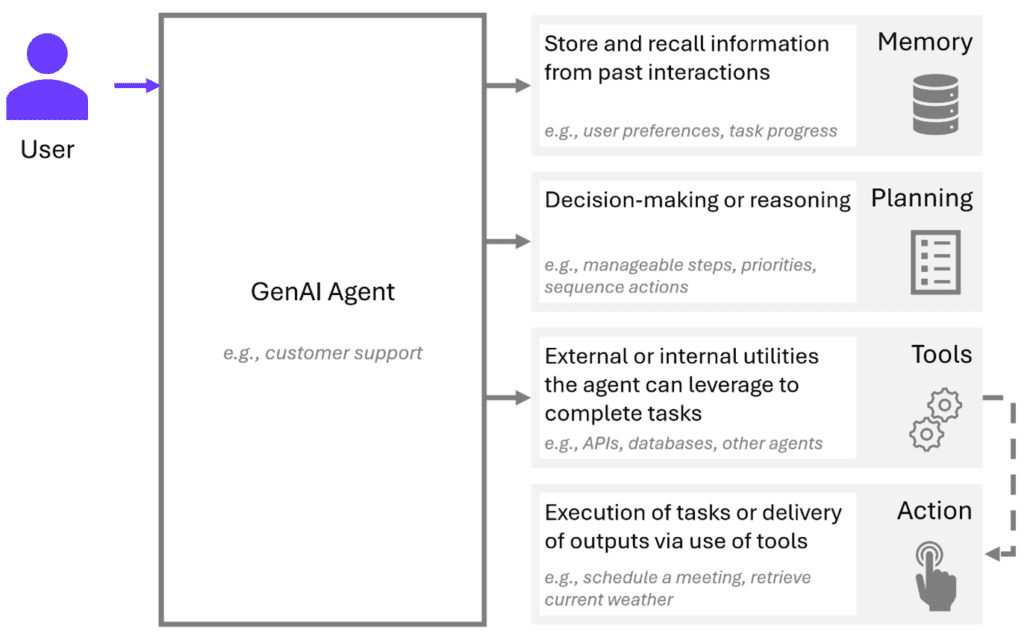
1. Interface: the bridge between you and the AI
The interface is the gateway through which users communicate with the GenAI agent. It serves as the medium for input and output, allowing users to ask questions, give commands, or provide data. Whether it’s a text-based chat, a voice command, or a more complex graphical user interface (GUI), the interface ensures the agent can understand human input and convert it into actionable data.
2. Memory: remembering what matters
Memory is what allows a GenAI agent to learn from past experiences and adapt over time. It stores both short-term and long-term information, helping the agent maintain context across interactions and deliver personalized experiences, based on past conversations and preferences.
3. Planning: charting the path to success
The planning component is the brain behind the agent’s decision-making process. This is essentially using the reasoning of an LLM to break down the problem into smaller tasks. When faced with a task or problem, the agent doesn’t just act blindly. Instead, it analyses the situation, sets goals and priorities, and devises a strategy to accomplish them. This ability to plan ensures that the agent doesn’t simply react in predefined ways, but adapts its actions for both simple and complex scenarios.
4. Tools: extending the agent’s capabilities
No GenAI agent is an island— it needs to access additional resources to solve more specialized problems. Tools can be external resources, APIs, databases, or even other specialized (GenAI) agents that the agent can use to extend its functionality. By activating tools as prompted by the GenAI agent when needed, the agent can perform tasks that go beyond its core abilities, making it more powerful and versatile.
5. Action: bringing plans to life
Once the agent has formulated a plan, it’s time to take action. The action component is where the agent moves from theory to practice, executing tasks, sending responses, or interacting with tools and external systems. It’s the moment where the GenAI agent delivers value by fulfilling its purpose, completing a task, or responding to a user request.
The core components of a GenAI agent in action
Now that we’ve broken down the core components of a GenAI agent, let’s see how they come together in a real-world scenario. Let’s get back to our customer support example and imagine a customer who is inquiring about the status of their order. Here’s how the agent seamlessly provides a thoughtful, efficient response:
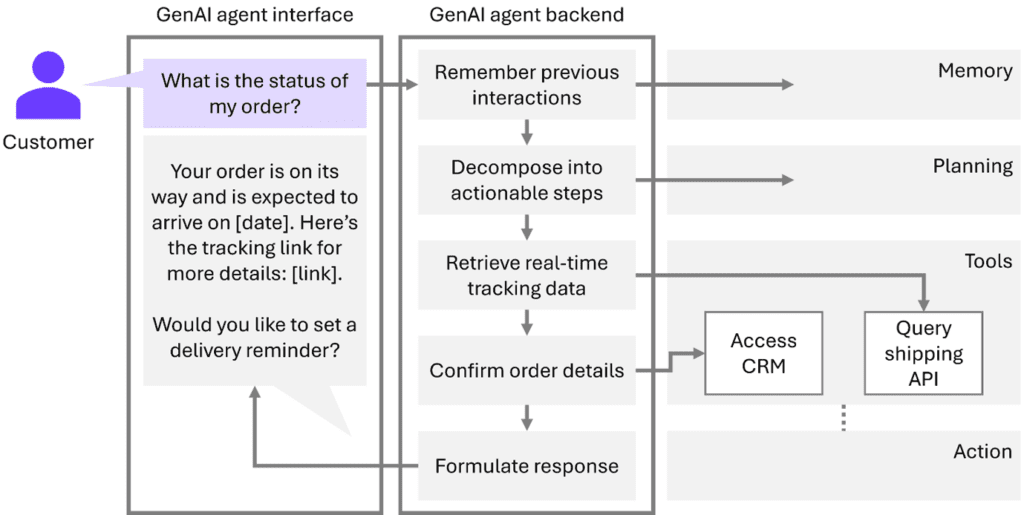
- Interface: The agent receives the customer query, "What is the status of my order?"
- Memory: The agent remembers the customer placed an order on January 15th 2025 with order ID #56789 from a previous interaction.
- Planning: The agent breaks down the task into steps: retrieve order details, check shipment status, and confirm delivery date.
- Tools: The agent accesses the DHL API with the customer’s order reference to get the most recent status update and additionally accesses CRM to confirm order details.
- Action: The agent retrieves the shipping status, namely “Out for delivery” as of January 22nd, 2025.
- Interface: The agent sends the response back to the customer: "Your order is on its way and is expected to arrive on January 22nd, 2025. Here’s the tracking link for more details: [link]. Would you like to set a delivery reminder?"
If the customer opts to set a reminder, the agent can handle this request as well by using its available tools to schedule the reminder accordingly, something that basic automation would not be able to do.
Unlocking efficiency with multi-agent systems for complex queries
A single GenAI agent can efficiently handle straightforward queries, but real-world customer interactions often involve complex, multifaceted issues. For instance, a customer may inquire about order status while also addressing delayed shipments, refunds, and promotions—all in one conversation. Managing such tasks sequentially with one agent increases the risk of delays and errors.
This is where multi-agent systems come in. By breaking down tasks into smaller, specialized subtasks, each handled by a dedicated agent, it’s easier to ensure and track efficiency and accuracy. For example, one agent handles order tracking, another manages refunds, and a third addresses promotions.
Splitting tasks this way unlocks several benefits: simpler models can tackle reduced complexity, agents can be given specific instructions to specialize in certain areas, and parallel processing allows for approaches like majority voting to build confidence in outputs.
With specialized GenAI agents working together, businesses can scale support for complex queries while maintaining speed and precision. This multi-agent approach outperforms traditional customer service, offering a more efficient and accurate solution than escalating issues to human agents.
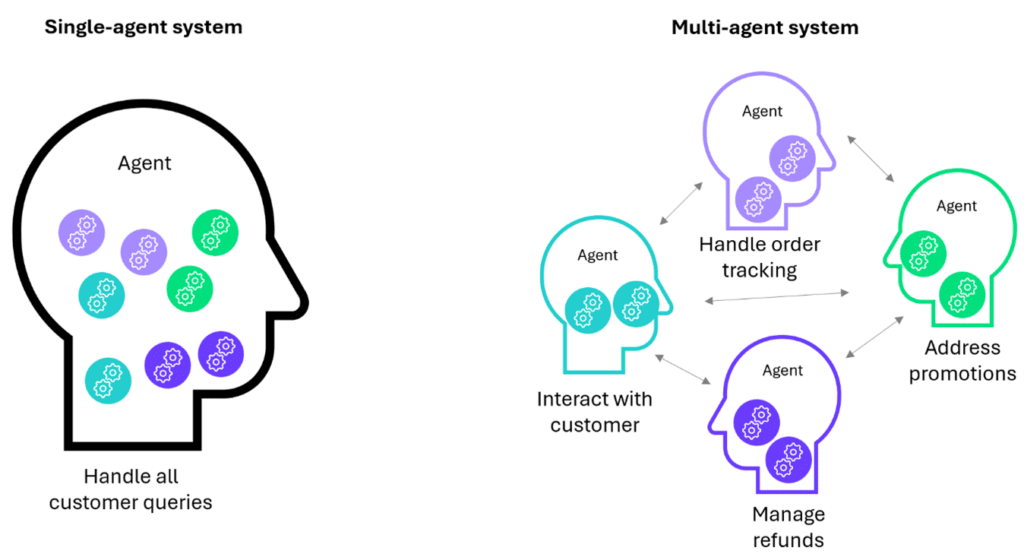
What is needed to design GenAI agents?
Whether you’re automating customer support, enhancing business processes, or revolutionizing healthcare, building effective GenAI agents is a strategic endeavor that requires expertise across multiple disciplines.
At the core of building a GenAI agent is the integration of key components that enable its functionality and adaptability:
- Data engineering. The foundation of any GenAI agent is its ability to access and process data from multiple sources. This includes integrating APIs, databases, and real-time data streams, ensuring the agent can interact with the world outside its own environment. Effective data engineering enables an agent to access up-to-date information, making it dynamic and capable of handling a variety of tasks.
- Prompt engineering. For a large language model to perform effectively in a specific domain, it must be tailored through prompt engineering. This involves crafting the right inputs to guide the agent’s responses and behavior. Whether it’s automating customer inquiries or analyzing medical data, domain-specific prompts ensure that the agent’s actions are relevant, accurate, and efficient.
- Experimentation. Designing workflows for GenAI agents requires balancing autonomy with accuracy. During experimentation, developers must refine the agent’s decision-making process, ensuring it can handle complex tasks autonomously while maintaining the precision needed to deliver valuable results. This iterative process of testing and optimizing is key to developing agents that operate efficiently in real-world scenarios.
- Ethics and governance. With the immense potential of GenAI agents comes the responsibility to ensure they are used ethically. This means designing systems that protect sensitive data, comply with regulations, and operate transparently. Ensuring ethical behavior isn’t just about compliance—it’s about building trust with users and maintaining accountability in AI-driven processes.

Transform potential into performance with GenAI
Whether you win or lose in your market may soon rely on having the best GenAI capability and the data foundations to support it. We can help you build this.
Discuss your needsChallenges and pitfalls with GenAI agents
While GenAI agents hold tremendous potential, there are challenges that need careful consideration:
- Complexity in multi-agent systems. Coordinating multiple specialized agents can introduce complexity, especially in ensuring seamless communication and task execution.
- Cost vs. benefit. With resource-intensive models, balancing the sophistication of GenAI agents with the cost of deployment is crucial.
- Data privacy and security. As GenAI agents require access to vast data and tools, ensuring the protection of sensitive information becomes a top priority.
- Ethical and regulatory considerations. Bias in training data, dilemmas around autonomous decision-making, and challenges in adhering to legal and industry-specific standards create significant risks. Deploying these agents responsibly requires addressing ethical concerns while navigating complex regulatory frameworks to ensure compliance.
- Performance management. Implementing agent systems effectively requires overcoming the complexity of monitoring and optimizing their performance. From breaking down reasoning steps to preparing systems and data for smooth access, managing the performance of these agents as they scale remains a significant hurdle.
Unlocking the future of GenAI agents with insights and discoveries ahead - stay tuned!
GenAI agents represent an exciting shift in how we approach problem-solving and human-computer interaction. With their promise to reason, plan, and execute tasks autonomously, these agents have the potential to tackle even the most complex workflows. As we continue our exploration of these systems, our focus will remain on understanding both their immense promise and the challenges they present.
In the coming weeks, we will delve deeper into the areas where GenAI agents excel, where they struggle, and what can be done to enhance their real-world effectiveness. We invite you to follow along with us as we share our experiments, findings, and practical insights from this ongoing journey. Stay tuned for our next blog post, where we will explore the evolving landscape of GenAI agents, along with the valuable lessons we have learned through experimentation.
This article was written by Mirte Pruppers, Data Scientist, Phebe Langens, Data Scientist, and Simon Koolstra, Principal at Rewire.
From interoperability to generative data management, here are the key trends shaping the data management agenda
Curious about what 2025 holds for Data Management? This article offers a strategic perspective on the trends that we expect will demand the most attention.
But first things first: let’s look at where we are today.
It is widely recognized that Data Management is the main bottleneck when scaling AI solutions. More and more companies see the benefits of good data management when building scalable data & AI capabilities. In fact, to do anything meaningful with data, your business must organize for it.
However, there is no one-size-fits-all data management strategy. How to organize depends on what you want to accomplish and what your business considers critical. Regardless of whether your organization adopted defensive or offensive data strategies, 2024 was marked by the fact that nearly all companies were addressing these three challenges:
- Balancing centralization versus decentralization. Data mesh principles bring data federation into focus. That is, strategically determining the level of domain autonomy versus standardization in order to balance agility with consistency.
- Explicitly linking data management with use case value. Many companies have started properly building a business case for data. Both value and costs have become part of the equation, as part of a shift from big data to high quality data.
- Managing the trade-off between flexibility, scalability and technical debt. This involves deciding between highly automated, low-code platforms for users of varying technical skills vs. high-code frameworks for experienced developers who work on tailored solutions.
Moving on to 2025, we expect the key trends to be:
- Interoperability –to overcome heterogeneous technologies and data semantics across organizational siloes.
- Generative data management –to enable both GenAI use cases from the information contained in the data, as well as GenAI data governance agents.
- Balancing data democratization with people capabilities –to foster high quality decision-making. This involves both high data trustworthiness and building people's ability to work with the data.
Now let's review them one by one.
Trend #1. Interoperability
Building scalable data management typically evolves to a stage where decentralized domain teams take ownership, and data definitions and discoverability are effectively addressed. However, this creates a landscape with both heterogeneous technology and data across domains. For companies that have adopted offensive data strategies, this means that domain-transcending use cases are hampered as the underlying data cannot be integrated. For companies that have adopted defensive data strategies, this means that meeting the regulatory requirements (e.g. CSRD) that require company-wide integrations, are at risk. Either way, the promise of interoperability is to reap the value for cross-domain use cases.
When designing interoperability solutions, we need to start by asking what data should be common across domains and how to handle the heterogeneity over domains to deliver the value in cross-domain use cases. Here the challenge from heterogeneous data can be expected to be more complex than the challenge that stems from heterogeneous technology.
What about implementation? While property graphs, ontologies, query federation engines and semantic mapping technologies are serious contenders for providing a strong technological basis for interoperability, scaling these solutions remain unproven. However, we anticipate that 2025 will be a breakthrough year, with leading companies in data management demonstrating successful large-scale implementations—potentially integrating access management solutions as an additional layer atop the interoperability framework.
The journey doesn’t stop there: achieving end-to-end interoperability hinges on the collaboration of your people. Addressing use cases with cross-domain questions demands a coalition of domain experts working together to craft semantic models and establish a shared language, essential for breaking down silos and fostering seamless integration.
Trend #2. Generative data management
Whereas the general public enthusiastically adopted GenAI in 2024, we expect 2025 to be marked by the integration of GenAI into business processes. However, successfully embedding this new class of data solutions will depend heavily on effective data management.
Drawing parallels with predictive AI, it’s clear that integrating GenAI into business operations requires robust data management frameworks. Without this foundation, businesses risk a proliferation of siloed point solutions, which later require costly redevelopment to scale. Moreover, the risks associated with the classic "garbage in, garbage out" rule are even more pronounced with GenAI, making high-quality data a critical prerequisite. In short: fix your data first.
Interestingly, GenAI itself can play a pivotal role in addressing data management challenges. For instance, GenAI-powered data governance stewards or agents can automate tasks like metadata creation and tracking data provenance. (Check out our article on Knowledge Graphs and RAG to learn more about their transformational powers.)
For companies with offensive data strategies, thriving with GenAI requires aligning its deployment with a solid data management strategy. Meanwhile, defensive strategies can leverage GenAI to automate tasks such as data classification, metadata generation, and tracking data lineage across systems.
To make all this work, companies must solve the challenges of technological interoperability, allowing GenAI use cases to access and benefit from diverse datasets across platforms. Since GenAI relies on a variety of labeled data to perform optimally, addressing these challenges is critical.
All in all, we believe 2025 will be the year GenAI begins transforming data management for businesses that recognize it requires a fundamentally different approach than predictive AI. The companies that adapt will lead the way in this next wave of innovation.
Trend #3. Balancing democratization of data with people capabilities
Many companies began their data transformation journeys on a small scale, often driven by technology. This has now led to broader data availability within organizations, bringing both opportunities and challenges. Two key outcomes are emerging:
First, to empower the right people, it's important to evaluate where you are today, and what responsibilities and competencies you require from the people within your organization. This feeds back into the level of abstraction of technical capabilities, the training curriculum and the purpose of your accelerator teams. For more details check out this blog post on data management adoption.
Second, trustworthiness and quality of the data becomes more critical than ever. Indeed, low quality data and lack of trust in the data can cause significant organizational noise and costs. (Consider the impact of erroneous sales data accessed by 100 users and systems, with all reports and decisions based on it propagating those inaccuracies).
For companies with offensive data strategies, high-quality data products enable scalability, allowing less technical domain experts to contribute more effectively to building solutions. For defensive strategies, robust trust and quality checks pave the way for "data management by design," enabling a shift from "human in the loop" to "human on the loop".
In sum, we believe 2025 will mark a turning point in data management, characterized by higher levels of automation and an improved developer experience. This will make data management more accessible to a wider range of people while requiring a step up in both people skills and data quality. Striking the right balance between these elements will be critical for success.
The road ahead
The market around data & AI is rapidly changing. It is also filled with noise, from the latest data management tools to emerging paradigms (e.g. data mesh, grid, fabric, and so on). Without a focused approach, it’s easy to lose sight of what truly matters for your organization.
Addressing this challenge is much like conducting an orchestra, where people, technology, and organizational elements must work in harmony on a transformational journey. Missteps can lead to isolated point solutions or inadvertently create a new bottleneck. But with the right mix of experience, skill, and knowledge, success is absolutely achievable. In an earlier blogpost we shared our perspective on making data management actionable. Are you ready to step into the role of the conductor, orchestrating data management for your organization? If so, contact us to share your experience!
This article was written by Nanne van't Klooster, Program Manager, Freek Gulden, Lead Data Engineer, and Frejanne Ruoff, Principal at Rewire.
It takes a few principles to turn data into a valuable, trustworthy, and scalable asset.
Imagine a runner, Amelia, who finishes her run every morning eager to pick up a nutritious drink from her favorite smoothie bar, "Running Smoothie”, at the corner of the street. But there’s a problem: Running Smoothie has no menu, no information about ingredients or allergens, and no standards for cleanliness or freshness. Even worse, some drinks should be restricted based on age — like a post-run mimosa — but there is no way to identify the drinks for adults only. For long time customers like Amelia, who know all products by heart, this isn’t much of an issue. But new customers, like Bessie, find the experience confusing and unpleasant, often deciding not to return.
Sounds strange, right? Yet, this is exactly how many organizations treat their data.
This scenario parallels the typical struggles organizations face in data management. Data pipelines can successfully transfer information from one system to another, but this alone doesn’t make the data findable, usable, or reliable for decision-making. Take a Sales team processing orders, for instance. That same data could be highly valuable for Finance, but it won’t deliver any value if the Finance team isn’t even aware the pipeline exists. This highlights a broader issue: simply moving data from point A to B falls short of a successful data exchange strategy.

Effectively sharing Data as a Product requires sharing described, observable and governed data to ensure a smooth and scalable data exchange.
In response to this, leading organizations are embracing data as a product — a shift in mindset from viewing data as an output, to treating data as a strategic asset for value creation. Transforming data into a strategic asset requires attention to three core principles:
- Describe: ensure users can quickly find and understand the data they need, just as a well-labeled menu listing ingredients and allergens helps Bessie know what she can order.
- Observe: share data quality and reliability over time, both expected standards and unexpected deviations — like information on produce freshness and flagging when customers must wait longer than usual for their drink.
- Govern: manage who can access specific data so only authorized individuals can interact with sensitive information, similar to restricting alcoholic menu items based on an age threshold.
By embedding these foundational principles, data is not just accessible but is transformed into a dependable asset to create value organization-wide. This involves carefully designing data products with transparency and usability in mind, much like one would expect from a reputable restaurant's menu.
In this blog, we will explore why each principle is essential for an effective data exchange.
Describe: ensure data is discoverable and well-described
For data to create value, consumers need to be able to find, understand, and use it. If your team produces a dataset that’s crucial to multiple departments but remains tucked away on a platform no one knows about or is not well described and remains ambiguous, your crucial dataset might as well be invisible to potential consumers.
Findable data requires a systematic approach to metadata: think of it as the digital “menu listing” of data that helps others locate and understand it. Key metadata elements include the data schema, ownership details, data models, and business definitions. By embedding these in, for example, a data catalog, data producers help their consumers not only discover data but also interpret it accurately for their specific needs.
Observe: monitor data quality and performance
The next step is to share data quality—consumers need to know that what they are accessing is reliable. Data lacking quality standards leave users guessing whether the data is recent, consistent, and complete. Without transparency, consumers might hesitate to rely on data or worse, make flawed decisions based on outdated or erroneous information.
By defining and sharing clear standards around data quality and availability —such as timeliness, completeness, and accuracy— you enable consumers to determine if the data meets their needs. Providing observability into performance metrics, such as publishing data update frequency or tracking issues over time, allows users to trust the data and promotes data quality accountability.
Govern: manage data access and security
Finally, a successful data product strategy is built on well-managed data access. While data should ideally be accessible to any team or individual who can create value from it, data sensitivity and compliance requirements must be taken into account. Yet, locking all data behind rigid policies slows down collaboration and might lead teams to take risky shortcuts.
A well-considered access policy strikes the right balance between accessibility and security. This involves categorizing data access levels based on potential use cases, and establishing clear guidelines on who can view, modify, or distribute data. Effectively managed access not only safeguards sensitive information but also builds trust among data producers, who can rest assured their data is treated confidentially. Meanwhile, consumers can access and use data confidently, without friction or fear of misuse.
Sounds easy, but the devil is in the details
For many, these foundational principles may seem straightforward. Yet, we often see companies fall into the trap of relying solely on technology to solve their Data & AI challenges, neglecting to apply these principles holistically. This tech-first approach often results in poor adoption and missed opportunities due to a lack of focus on organizational context and value delivery.
Take data catalogs, for example — essential tools for data discoverability. While it may seem like a simple matter of choosing the right tool, driving real change requires a comprehensive approach that incorporates best practices from the Playbook to Scalable Data Management. Without them, companies face long-term risks where:
- Due to a lack of standards the catalog features data duplication, inconsistent definitions, no clear or recursively looping data lineage, and so on. For consumers of the data, this makes it difficult to navigate eroding its usefulness.
- Due to a lack of requirements the catalog is helpful for some teams, but useless for others, inviting proliferation of alternative tools further complicating data access and reducing overall adoption.
This illustrates the fact that something as fundamental as a data catalog isn’t just a technological fix. Instead, it requires a coordinated, cross-functional effort that aligns with business priorities and data strategy: it is not about implementing the right tool, but about implementing the tool the right way.
Conclusion: Data as a Product, not just Data
In the end, successfully sharing data across an organization is about more than just setting up access points and handing over datasets. It demands a holistic approach to data discoverability, observability, and governance suited to your organization. By embedding these principles, organizations can overcome common pitfalls in data sharing and set up a robust foundation that turns data into a true organizational asset. It’s not only a strategic shift in data management but also a cultural one that lays the foundation for scalable, data-driven growth.
This article was written by Femke van Engen, Data Scientist, Simon Beets, Data & AI engineer, and Freek Gulden, Lead Data Engineer at Rewire.